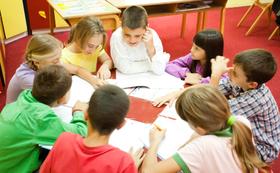The Perpich Center for Arts Education is an agency of the state of Minnesota that seeks to advance K-12 education throughout the state by teaching in and through the arts.
Perpich Center For Arts Education serves 144 students in grades 11-12.
The percentage of students achieving proficiency in math is 20-29% (which is lower than the Minnesota state average of 46%).
The student-teacher ratio of 8:1 is lower than the Minnesota state level of 13:1.
Minority enrollment is 17% of the student body (majority Black and Hispanic), which is lower than the Minnesota state average of 39% (majority Black).
Quick Facts (2025-26)
- Grades: 11-12
- Enrollment: 144 students
- Student-Teacher Ratio: 8:1
- Minority Enrollment: 17%
- Graduation Rate: ≥95% (Top 5% in MN)
- Math Proficiency: 20-29% (Btm 50%)
- Science Proficiency: ≥50% (Top 30%)
- Source: National Center for Education Statistics (NCES), MN Dept. of Education
Top Rankings
Perpich Center For Arts Education ranks among the top 20% of public schools in Minnesota for:
Category
Attribute
Graduation Rate
Student Attention
School Overview
Perpich Center For Arts Education's student population of 144 students has grown by 28% over five school years.
The teacher population of 19 teachers has grown by 46% over five school years.
Grades Offered
Grades 11-12
(No virtual instruction)
(No virtual instruction)
Total Students
144 students
Gender %
Total Classroom Teachers
19 teachers
Year Founded
1985
School Calendar
School Mascot
Artistic Eagles
School Rankings
The diversity score of Perpich Center For Arts Education is 0.31, which is less than the diversity score at state average of 0.59. The school's diversity has stayed relatively flat over five school years.
Math Test Scores (% Proficient)
20-29%
46%
Science Test Scores (% Proficient)
≥50%
41%
Student-Teacher Ratio
8:1
13:1
American Indian
1%
2%
Asian
n/a
7%
Hispanic
5%
12%
Black
5%
12%
White
83%
61%
Hawaiian
n/a
n/a
Two or more races
6%
6%
All Ethnic Groups
Graduation Rate
≥95%
84%
Eligible for Free Lunch
17%
36%
Eligible for Reduced Lunch
5%
7%
School Statewide Testing
School District Name
Source: National Center for Education Statistics (NCES), MN Dept. of Education
School Notes
- School Mascot: Artistic Eagles
Profile last updated: 02/09/2025
Frequently Asked Questions
What is the graduation rate of Perpich Center For Arts Education?
The graduation rate of Perpich Center For Arts Education is 95%, which is higher than the Minnesota state average of 84%.
How many students attend Perpich Center For Arts Education?
144 students attend Perpich Center For Arts Education.
What is the racial composition of the student body?
83% of Perpich Center For Arts Education students are White, 6% of students are Two or more races, 5% of students are Black, 5% of students are Hispanic, and 1% of students are American Indian.
What is the student-teacher ratio of Perpich Center For Arts Education?
Perpich Center For Arts Education has a student ration of 8:1, which is lower than the Minnesota state average of 13:1.
What grades does Perpich Center For Arts Education offer ?
Perpich Center For Arts Education offers enrollment in grades 11-12 (No virtual instruction).
What school district is Perpich Center For Arts Education part of?
Perpich Center For Arts Education is part of Perpich Center For Arts Education School District.
School Reviews
Review Perpich Center For Arts Education. Reviews should be a few sentences in length. Please include any comments on:
- Quality of academic programs, teachers, and facilities
- Availability of music, art, sports and other extracurricular activities
Recent Articles

Public School Open House & Enrollment Season Guide
A parent-focused guide to the public school open house and enrollment season, with expert questions, timelines, and decision tips.

School Supply Budget 2026: Fees, Books, Tech Costs
School Supply Budget 2026 guide for parents, covering fees, textbooks, technology, and hidden extras to plan ahead.

Education Funding in America (2025 Update)
Comprehensive 2025 update on public school funding in America, new federal and state policies, per-pupil spending, and equity challenges.





